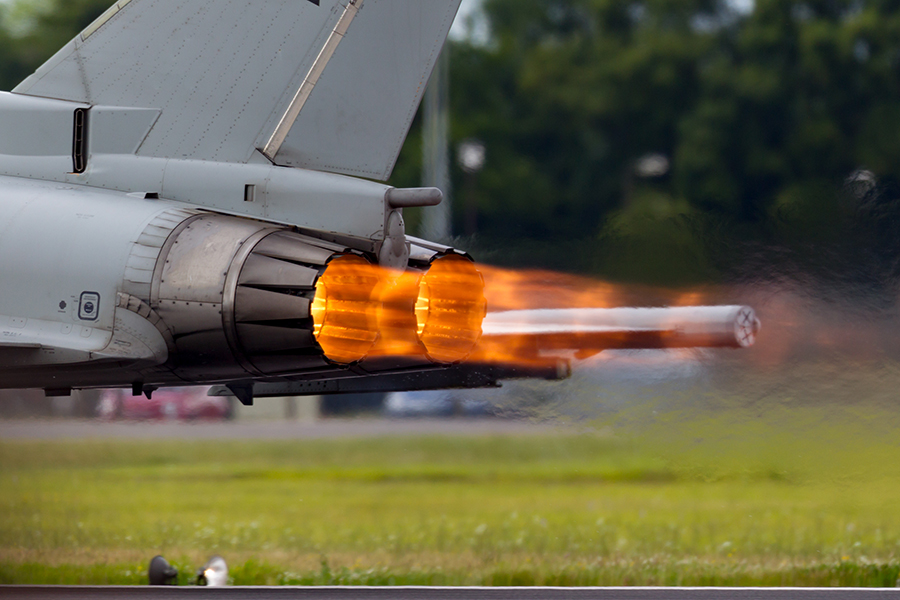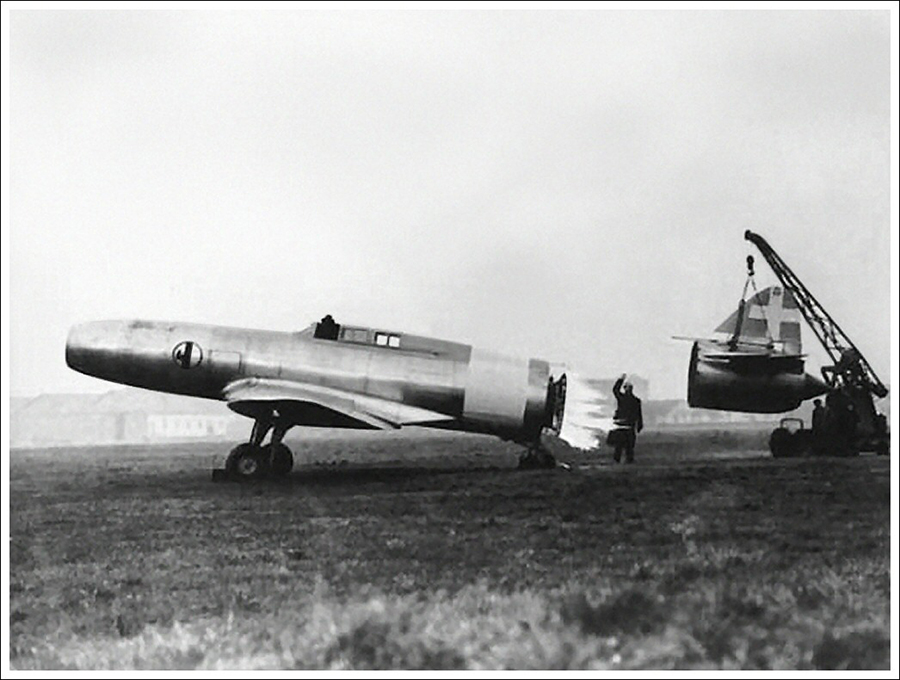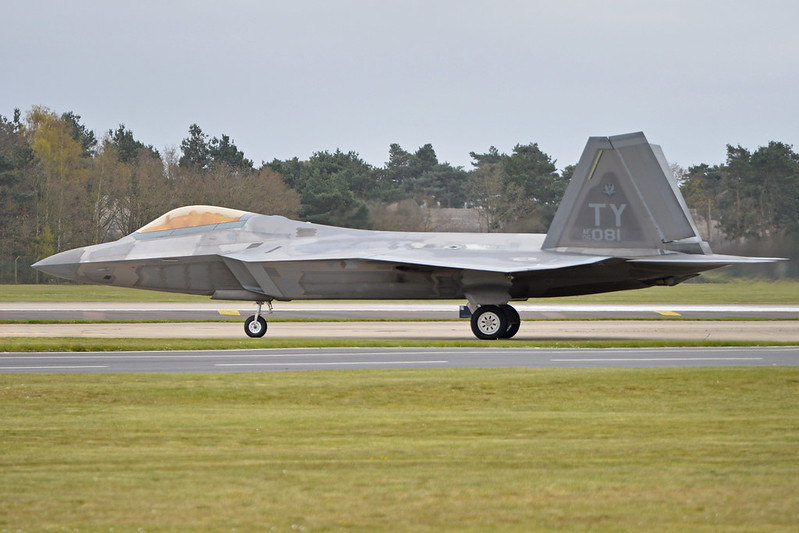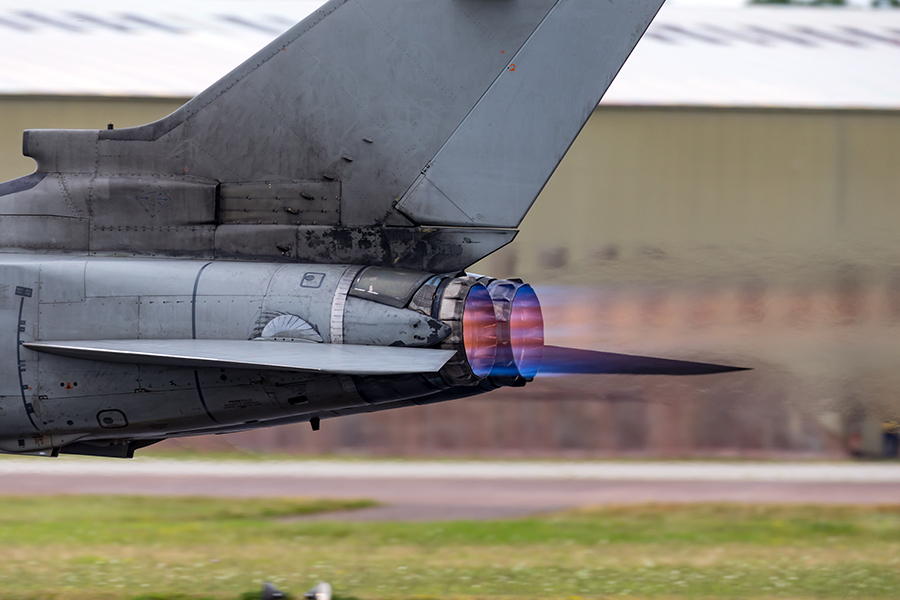Ever seen the flame that sometimes appears at the back of an aircraft? That’s an afterburner, and it’s used when a jet aircraft needs extra thrust.
But what exactly is an afterburner, how is it used, and what will afterburners look like in the future? Fasten your seatbelts; we’re about to dive deep into the world of jet engine afterburners.
What Is an Afterburner?
An afterburner (also known as “reheat” by our British friends) is a device added to some jet engines and mainly used on supersonic military aircraft. The afterburner’s purpose is to dramatically increase thrust, usually for supersonic flight, takeoff, and combat situations.
To achieve afterburning, additional fuel is injected into the jet pipe downstream (i.e., toward the back) of the turbine. Afterburning yields a more significant amount of thrust without the need to increase the total power output of the engine traditionally (e.g., by making the engine bigger). The disadvantages, such as high fuel consumption and inefficiency, are usually seen as an acceptable tradeoff for the short periods it is employed.
Jet engines are denoted as wet when afterburning and dry when not afterburning. The term “maximum power” means that an engine is producing maximum thrust wet (with an afterburner), and “military power” means that an engine is producing maximum thrust dry (without an afterburner).
How Does an Afterburner Work?
To understand how an afterburner works, we need to have a basic understanding of how jet engines produce thrust.
A jet engine produces thrust based on Newton’s third law of motion, which states that for every action, there is an equal or opposite reaction. In other words, the more force a jet engine can produce, the more thrust it will have. A jet engine produces this force through the acceleration of the air passing through it.

There are two ways a jet engine can produce more thrust:
- Accelerating the air to a higher velocity
- Accelerating a greater mass of air from the engine
A turbofan engine is designed around the second principle and ejects slower air but more of it. Turbofans are designed for fuel efficiency and high thrust for extended periods, but the tradeoff is that they need to be large compared to the amount of maximum thrust they can produce.
This is where the afterburner comes to the rescue. Afterburners generate a larger amount of thrust by accelerating the air mass passing through the engine, without the need to increase the engine size.
This rapid acceleration of air is achieved by injecting fuel into an extended exhaust nozzle section. This fuel is ignited by igniters located in the nozzle section, and the air rapidly accelerates as a result. A regular jet engine typically only uses up half of the oxygen it takes in, so there is much more potential power available. The afterburner ignites much of this unused oxygen after mixing it with fuel.
This nozzle section usually expands mechanically to accommodate for the significant increase in velocity and volume. This prevents potential compressor stalls caused by the air reversing direction and re-igniting.
The Limitations of Afterburners
Afterburners are a great way to add more thrust to a jet engine, but they have a few limitations.
The most significant disadvantage of afterburners is the high fuel consumption. Afterburners use a lot of fuel, which can be a problem for military aircraft that need to stay in the air for long periods at a time.
Another disadvantage of afterburners is that they are not very efficient. Because afterburners inject fuel into the exhaust nozzle, a lot of the energy from the burning fuel is wasted. This significantly decreases its overall efficiency.
The extent of the increase in thrust differs. The afterburners on the Olympus engines that powered the Concorde supersonic jet only increased thrust by a mere 17 percent. The thrust increase in modern military aircraft often ranges from approximately 40 to 70 percent (with a significant increase in fuel consumption).
Finally, using an afterburner can also cause the engine to stall. When the airflow reverses direction, it can cause the compressor blades of the engine to stall. This is typically prevented by expanding the exhaust nozzle section as thrust is increased, but this adds weight and complexity to the engine.
Because they use so much fuel, afterburners are only used when you need a lot of thrust over a short period. Afterburners are commonly used when an aircraft takes off from a short runway, launches from an aircraft carrier, or during air combat. The Pratt & Whitney J58 engine is a notable exception; it was used in the SR-71 Blackbird and allowed for prolonged use of its afterburner. This made in-flight refueling mandatory for every reconnaissance mission.
What Are the Rings in an Afterburner?
Afterburners produce a very large flame at the back of the aircraft. This exhaust flame may display shock diamonds, which are caused by shock waves. These shock waves occur due to small differences between the exhaust pressure and the ambient pressure. The exhaust flame’s diameter fluctuates due to these imbalances, and this causes the visible banding where pressure and temperature are most intense.
The History of Afterburners

On April 11, 1941, the first flight of the Caproni Campini C.C.2 motorjet took place – the first aircraft to be designed with an afterburner.
In late 1944, an early British version of the afterburner (known as “reheat”) began flight tests in a Gloster Meteor, the first jet fighter built by the allies and the only allied jet fighter to see combat during the Second World War.
Afterburner research in the United States began shortly after in Cleveland, Ohio, by the National Advisory Committee for Aeronautics (NACA was dissolved and integrated into the National Aeronautics and Space Administration (NASA) in 1958).
Developments in the 1950s led to the creation of several large afterburning engines, such as the Orenda Iroquois and the British de Havilland Gyron. The Rolls-Royce Avon RB.146 variants powered the English Electric Lightning, the first supersonic aircraft used by the RAF. Afterburners on the Bristol-Siddeley Rolls-Royce Olympus were a joint effort by Bristol Siddeley and Solar of San Diego. The afterburner system for Concorde, however, was developed solely by Snecma.
Afterburners are not commonly used in civilian aircraft, with a few exceptions, such as some NASA research aircraft, the Tupolev Tu-144, and Concorde.
Concorde notably flew long distances at supersonic speeds. Afterburner use is not fuel efficient, thus making it impossible to fly at high speeds for extended periods of time. However, utilizing an afterburner during takeoff and climb allows the aircraft to accelerate quickly and reduces the time spent in the low-speed, high-drag transonic flight regime. Flying supersonically without an afterburner is known as “supercruise.”
The Future of Afterburners

Even when the afterburner is not engaged, radar waves entering the open tailpipe will reflect radar signals, potentially revealing the aircraft’s position to the enemy. Not to mention, the infrared emissions from an activated afterburner and its nozzle are practically impossible to conceal. As such, many early stealth aircraft scrapped the afterburner design in favor of a stealthier exhaust system.
The turbofan, which mixes cool air with turbine exhaust gases, helps reduce the signature, but not sufficiently enough to use during stealth operations.
Future designs of aircraft featuring afterburner nozzles that are cooled by bypass air may be able to mask the infrared emissions from the exhaust. Engineers are also researching construction materials that could absorb heat, similar to how space shuttle thermal tiles work, as well as other engine designs that would make afterburners stealthier.
However, it is impossible to completely conceal a stream of hot air coming from the back of a fighter jet. Currently, the only viable method to maintain stealth is by lessening the aircraft’s dependence on afterburners. For example, the F-22A can cruise at approximately 1.5 Mach (one and a half times the speed of sound) without igniting its afterburner.
Aviation engineers predict that afterburners will still be used well into the 21st century. Not only are they commonly used for carrier takeoffs, but the extra speed is also helpful in combat situations. As long as military pilots might need an added burst of power, afterburners seem to be the best solution.
Conclusion
Afterburners are a feature of many jet-powered aircraft. They provide an extra burst of speed and power that is mainly used in military settings. Even though they aren’t as fuel efficient as other forms of propulsion, afterburners remain a popular choice for aircraft designers.
Aviation engineers predict that afterburners will still be used well into the 21st century. However, with the latest advances in stealth technology, afterburners may eventually be replaced by more efficient alternatives. Nevertheless, until then, afterburners remain a vital tool for jet-powered aircraft.



